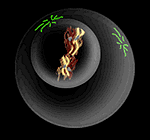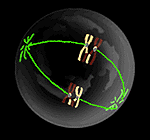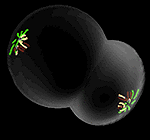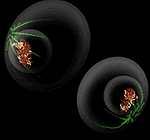CELL DIVISION: MEIOSIS I & II
Sexual reproduction occurs only in
eukaryotes.
During the formation of gametes,
the number of chromosomes
is reduced by half, and returned to the full amount when the two
gametes
fuse during fertilization.
Meiosis
involves two successive divisions of a diploid (2N) eukaryotic cell of a
sexually reproducing organism that result in four haploid (N) progeny
cells, each with half of the genetic material of the original cell.
Through the mechanisms by which paternal and maternal chromosomes
segregate, and the process of crossing-over, genetic variation is
produced in the haploid cells.
|
 |
•
Meiosis occurs in diploid cells. The chromosomes duplicate once, and
through two successive divisions, four haploid cells are produced, each
with half the chromosome number of the parental cell.
• Meiosis occurs only in sexually reproducing organisms. Depending on the organism, it may produce haploid gametes, which do not divide further but instead fuse to produce a diploid zygote; or it may produce haploid spores, which divide by mitotic cell cycles and produce unicellular or multicellular organisms. • In animals, where the somatic (body) cells are diploid, the products of meiosis are the gametes. • In many fungi and some algae, meiosis occurs immediately after two haploid cells fuse, and mitosis then produces a haploid multicellular "adult" organism (e.g., filamentous fungi, algae) or haploid unicellular organisms (e.g., yeast, unicellular algae). • Plants and some algae have both haploid and diploid multicellular stages. The multicellular diploid stage is the sporophyte. Meiosis in a sporophyte produces haploid spores. These spores alone are capable of generating a haploid multicellular stage called a gametophyte. The gametophyte produces gametes by mitotic cell cycles.
Ploidy: Number of sets of chromosomes in a cell
|
What is meiosis I?
| In meiosis I, chromosomes in a diploid cell resegregate, producing four haploid daughter cells. It is this step in meiosis that generates genetic diversity. |
The phases of meiosis I & II
Meiosis consists of two successive nuclear divisions, meiosis I and meiosis II. Each division consists of these stages: prophase, metaphase, anaphase, and telophase.
Prophase I

|
DNA replication precedes the start of meiosis I. During prophase I, homologous chromosomes pair and form synapses, a step unique to meiosis. The paired chromosomes are called bivalents, and the formation of chiasmata caused by genetic recombination becomes apparent. Chromosomal condensation allows these to be viewed in the microscope. Note that the bivalent has two chromosomes and four chromatids, with one chromosome coming from each parent. |
Prometaphase I

|
The nuclear membrane disappears. One kinetochore forms per chromosome rather than one per chromatid, and the chromosomes attached to spindle fibers begin to move. |
Metaphase I

|
Bivalents, each composed of two chromosomes (four chromatids) align at the metaphase plate. The orientation is random, with either parental homologue on a side. This means that there is a 50-50 chance for the daughter cells to get either the mother's or father's homologue for each chromosome. |
Anaphase I

|
Chiasmata separate. Chromosomes, each with two chromatids, move to separate poles. Each of the daughter cells is now haploid (23 chromosomes), but each chromosome has two chromatids. |
Telophase I

|
Nuclear envelopes may reform, or the cell may quickly start meiosis II. |
Cytokinesis

|
Analogous to mitosis where two complete daughter cells form. |
| Meiosis II is similar to mitosis. However, there is no "S" phase. The chromatids of each chromosome are no longer identical because of recombination. Meiosis II separates the chromatids producing two daughter cells each with 23 chromosomes (haploid), and each chromosome has only one chromatid. | |
| Prophase II | |
| Meiosis II begins without any further replication of the chromosomes. In prophase II, the nuclear envelope breaks down and the spindle apparatus forms. | |
| • While chromosome duplication took place prior to meiosis I, no new chromosome replication occurs before meiosis II. • The centrioles duplicate. This occurs by separation of the two members of the pair, and then the formation of a daughter centriole perpendicular to each original centriole. The two pairs of centrioles separate into two centrosomes. • The nuclear envelope breaks down, and the spindle apparatus forms. |

Metaphase II
The chromosomes
become arranged on the metaphase plate, much as the chromosomes do in
mitosis, and are attached to the now fully formed spindle.
• Each of the daughter cells completes the formation of a spindle apparatus.
• Single chromosomes align on the metaphase plate, much as chromosomes do in mitosis. This is in contrast to metaphase I, in which homologous pairs of chromosomes align on the metaphase plate.
• For each chromosome, the kinetochores of the sister chromatids face the opposite poles, and each is attached to a kinetochore microtubule coming from that pole.
• Single chromosomes align on the metaphase plate, much as chromosomes do in mitosis. This is in contrast to metaphase I, in which homologous pairs of chromosomes align on the metaphase plate.
• For each chromosome, the kinetochores of the sister chromatids face the opposite poles, and each is attached to a kinetochore microtubule coming from that pole.

Anaphase II
The centromeres separate and the sister chromatids—now individual chromosomes—move toward the opposite poles of the cell.
• The centromeres separate, and the two chromatids of each chromosome
move to opposite poles on the spindle. The separated chromatids are now
called chromosomes in their own right.
Telophase II
A nuclear envelope
forms around each set of chromosomes and cytokinesis occurs, producing
four daughter cells, each with a haploid set of chromosomes.
• A nuclear envelope forms around each set of chromosomes.
• Cytokinesis takes place, producing four daughter cells (gametes, in animals), each with a haploid set of chromosomes.
• Because of crossing-over, some chromosomes are seen to have recombined segments of the original parental chromosomes.


Gametogenesis
Gametogenesis is the process of forming gametes (by definition haploid, n) from diploid cells of the germ line. Spermatogenesis is the process of forming sperm cells by meiosis (in animals, by mitosis in plants) in specialized organs known as gonads (in males these are termed testes). After division the cells undergo differentiation to become sperm cells. Oogenesis is the process of forming an ovum (egg) by meiosis (in animals, by mitosis in the gametophyte in plants) in specialized gonads known as ovaries. Whereas in spermatogenesis all 4 meiotic products develop into gametes, oogenesis places most of the cytoplasm into the large egg. The other cells, the polar bodies, do not develop. This all the cytoplasm and organelles go into the egg. Human males produce 200,000,000 sperm per day, while the female produces one egg (usually) each menstrual cycle.


Spermatogenesis
Sperm production begins at puberty at continues throughout life, with several hundred million sperm being produced each day. Once sperm form they move into the epididymis, where they mature and are stored.

Oogenesis
The ovary contains many follicles composed of a developing egg surrounded by an outer layer of follicle cells. Each egg begins oogenesis as a primary oocyte. At birth each female carries a lifetime supply of developing oocytes, each of which is in Prophase I. A developing egg (secondary oocyte) is released each month from puberty until menopause, a total of 400-500 eggs.

No comments:
Post a Comment